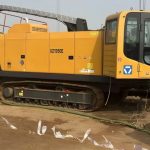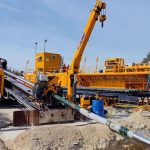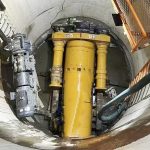Categories
Latest Updates





A new type of non-destructive testing technology AGIT (The Above Ground Inspection Technology), as a true non-invasive non-destructive testing technology, overcomes the limitations of ILI and ECDA, without the need for pigging and opening In special preparation situations, it is possible to directly assess the pipeline condition from the ground, locate and classify external and internal pipeline defects, and the production and operation of the pipeline are not affected by inspection. Therefore, economy and time cost can be effectively saved.
The AGIT detection technology is based on measuring the alternating magnetic field of a buried pipeline to determine the condition of the pipeline; the alternating magnetic field is induced by a special test current that is connected to the two end points of the pipeline, and the current contains multiple frequencies. Harmonic components ranging from several to several hundred hertz. The selected frequency range is determined by the electromagnetic characteristics of the pipe steel. When the pipeline is energized, due to the skin effect, the current density distribution along the pipe wall is related to the frequency. The higher the frequency, the higher the current concentration under the outer surface of the pipe wall. The lower frequency harmonic components flow through the entire pipe wall section, and the higher frequency harmonic components mainly flow through the thin layer under the outer surface of the pipe wall.
Since the steel pipe is made of ferromagnetic steel, another physical effect plays a vital role in metal damage identification. This is the stray magnetic flux from the tube wall. Similar to electric current, the radial distribution of the magnetic field on the pipe wall is also related to frequency. Due to the relatively high magnetic permeability of steel, the magnetic field density inside the tube wall is much higher than outside the tube wall. If there is metal damage, the magnetic field appears (deviation) from the tube wall over the defect, which causes a corresponding deformation of the surrounding magnetic field. This effect is also related to frequency. The deformation of the magnetic field will be recorded by the AGIT detection system and then identified when the data is evaluated.
When considering the presence or absence of metal damage on the tube wall, the shape of the magnetic field curve is significantly different. When there is no metal damage in the pipeline as shown in figure (a), the surrounding magnetic field lines 1; 2 are round for some of the same field density, and have nothing to do with the frequency of the test current. When there is a metal loss failure in the pipeline (see Figure b). In this case, the surrounding magnetic field lines are elliptical, and their shape is related to the frequency of the test current. The magnetic field lines of the lowest frequency (3) and the highest frequency (4) at the same field density also illustrate this point.
The frequency-dependent deformation of the magnetic field lines not only exists when the metal is damaged outside, but also when it is damaged inside the metal. When metal damage occurs at different clock positions, the magnetic field lines will also be deformed, so that AGIT can identify the fault in any one position. When these two methods are used at the same time, by measuring and comparing the magnetic fields of different frequencies outside the pipeline, it is possible to clearly distinguish between “metal damage” and “no metal damage”.
The AGIT detection system uses not only one sensor, but six sensors in a straight line, which is perpendicular to the pipeline. In this way, the coverage depth of the pipeline and the actual current flowing through can be determined at the same time, and the system has also reached a higher sensitivity. In order to improve the inspection efficiency, the AGIT inspection equipment uses four sensor lines, which are arranged in parallel along the vertical direction of the pipeline. A 6×4 sensor matrix is established, the sensor array (SA) (Figure 2a). The AGIT sensor measures the magnetic field on the ground around the pipe (Figure 2b).
The signal output from the sensor is transmitted to the data acquisition module (DCM), the data is digitally stored, and used to determine the location of the pipeline related to SA and the actual test current in the pipeline. The DCM is equipped with a display to graphically display the actual pipe position (coverage depth and displacement) to ensure that the SA is at the position above the pipe in each step of the inspection.
After data collection, the stored magnetic field data will be evaluated in the EMPIT laboratory. Use frequency magnetic field data analysis algorithm to evaluate the test current based on two-dimensional comparison and digital filtering.
The algorithm also includes current independence analysis, because in the diagnosis process, the test current will change slightly at every moment and every position. For this purpose, specially developed evaluation software is used. The digital filtering in the software can essentially reduce various external interferences, such as distorted magnetic fields from power lines, moving vehicles, etc. Finally, the output of this analysis will be data on metal loss, girth weld location, coverage depth, and current leakage through the anti-corrosion coating. All the information will be aggregated into a final report.
The AGIT inspection system has been used for pipeline diagnosis for hundreds of kilometers. All buried steel pipelines can be diagnosed. Neither the type of coating nor the product being transported have any effect on the quality of the measurement. AGIT has been used to inspect oil, natural gas, chemical, water, aviation fuel, and brine pipelines, and to detect internal and external corrosive metal loss failures, blisters, dents, measuring instruments, rolling mill defects, and pipeline deformations. More than 90% of the defects diagnosed by the AGIT system have been verified by contact non-destructive testing, and the system is certified for testing 3 to 42 inch pipes. When inspecting this type of pipeline, the response threshold for defects is 20% metal loss. The AGIT inspection system can be used for seamless and longitudinal welded pipes. Spiral welded pipes can also be detected by additional filtering algorithms.
The AGIT inspection starts from the beginning of the connecting cable between the AGIT current source (CS) and the pipe connection point. As the connection point, different contact methods can be used: the available cathodic protection column, the above-ground part of the pipeline or the built-in valve, and the pipeline itself, allowing direct contact with the pipeline when the hole is excavated. For a range, only two contacts are required. The starting point is one of the two connection points. The DCM monitor displays real-time reports of pipeline depth, SA’s exact position, inspection current and SA position on the pipeline. The analysis and calculation process of the magnetic field data takes about 6 seconds. During this period, the system should not move. After that, SA and DCM will be moved 1 m further for the next inspection. The storage of data occurs after each step. The sensors installed in SA can seamlessly capture and analyze magnetic field data, and make the average efficiency of inspectors reach 800 meters per day (depending on the surface of the pipeline).
This technology is suitable for almost all challenging buried pipelines, and it is also suitable for the detection of piggyable pipelines. If the pipeline is piggyable, AGIT can be used for regular monitoring to the extent that the intelligent pigging shows small defects that have not been repaired. In this case, AGIT is an inexpensive alternative to verification, mining and monitoring. Before ECDA, AGIT can also be used for metal damage screening, so as to determine a pipeline in a suspicious range, and then perform excavation verification. The surveyed terrain ranges from plains, forests to cities. At the same time, after checking the parallel pipelines, field experience shows that there is no impact on the accuracy of the measurement data when the pipeline spacing is greater than 60cm.
The online inspection tool (ILI) is used to monitor abnormal conditions in the pipeline, and its size can be as small as a few millimeters. However, pigs are limited by the geometry of the pipeline, so 50% of the global pipeline network cannot be pigs. AGIT is an advanced screening technology that can monitor the safety of each metal pipeline without interrupting production or directly entering the pipeline. Its work is independent of the geometry of the pipeline, and the information provided by AGIT cannot be replaced by traditional integrity tools or online inspection services.
The long-term AGIT inspection experience of this project shows that if AGIT can identify minor metal loss failures, it will be very beneficial to pipeline operators. This is because in some cases, depending on the operating pressure, wall thickness and pipe diameter, the critical size of the defect will be lower than the reference defect (50mm x 50mm x 50% of the metal loss, and the probability of detection (POD) is not less than 96 %). The further development and improvement of AGIT detection technology is to achieve the following goals: 1. Under “normal” working conditions, better reduce electromagnetic interference from the outside; 2. Higher sensitivity to smaller defects; 3. More Define the failure size of the pipeline well. Therefore, a clustering matrix containing 3-4 dimensions will be introduced to define the size of failure defects. In addition, the system will be changed from three to two to operate, and the daily inspection efficiency will be increased to 1000m in the future.
